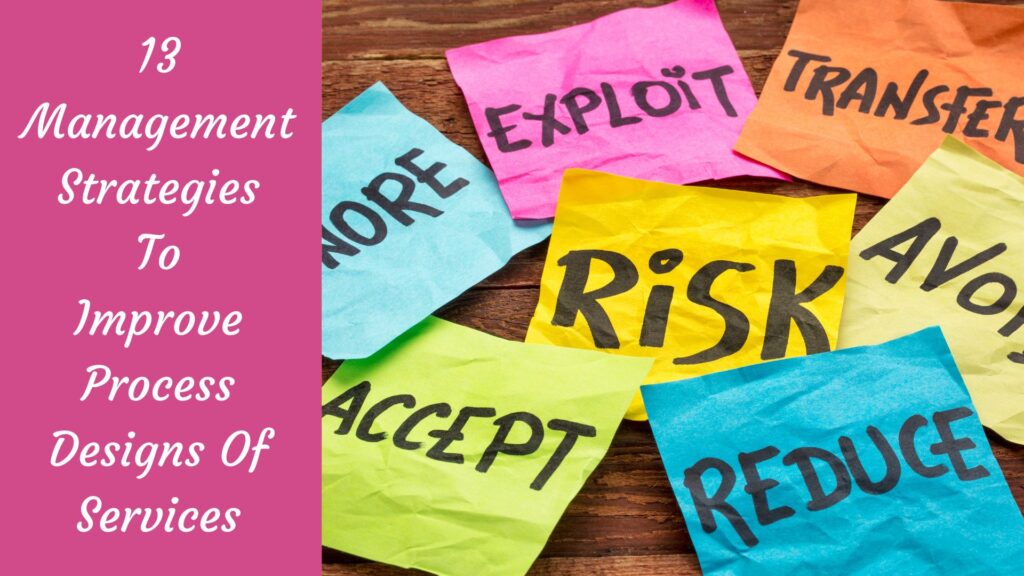In today’s fast-paced world, businesses in the service sector often struggle to stay ahead. With rising competition and increasing customer demands, the challenge to deliver top-notch services efficiently is more pressing than ever. Companies grapple with outdated processes, leading to dissatisfied customers and missed opportunities.
But how do you streamline operations and ensure satisfaction at every customer touchpoint with naturally-management strategies to improve process designs of services focus on? This is where our blog comes to the rescue.
With 13 groundbreaking management strategies to revamp your service process designs, we provide actionable solutions that promise to transform your business. Step into the future of service excellence and leave the competition behind.
Understanding Service Process Design
At its core, service process design entails mapping out and optimizing the way your business delivers services to customers. Think of it as drawing up the ultimate game plan for how your team interacts with customers, from the first “hello” to the final “thank you.” Naturally-management strategies to improve process designs of services focus on:
- Definition of service process design: It’s a blueprint of the steps and actions your business takes to deliver a kick-butt experience to your customers. This includes everything from how you greet them, solve their problems, and even follow up after a service is completed.
- The role of service process design in businesses: Imagine walking into a sandwich shop where you’re immediately greeted with a smile, your order is taken swiftly, and your sandwich is made exactly how you like it, all in record time. That’s service process design doing its magic. It’s all about creating a process so smooth, that your customers glide from point A to B without a hitch.
The impact of good and poor service process design:
- Good Design: You know that feeling when you hang up the phone or walk out of a store feeling like a rockstar because the service was just that good? That’s the power of a well-thought-out service process. Companies that nail it, like Apple with its Genius Bar, set the gold standard for what customer service should be.
- Poor Design: On the flip side, remember the last time you were stuck on hold for what felt like an eternity, only to be transferred around without getting your issue resolved? That’s poor service process design at work. It leaves customers frustrated, decreases loyalty, and can even lead to lost business.
Great service process design doesn’t happen overnight. However, by understanding its definition, role, and impact, businesses can start making strategic changes that turn average experiences into extraordinary ones.
The Need for Management Strategies in Service Process Design
Dialog sprawls across every business sector about the essence of adapting and evolving, more so in the realm of service delivery. Without a shadow of a doubt, management strategies stand as the backbone in the orchestration of efficient service process designs naturally. They are not just plans on paper; they are actionable insights that breathe life into the way services are crafted and delivered.
Why Management Strategies are Vital: Simply put, without these strategies, businesses risk becoming dinosaurs in a highly digital and customer-centric age. They:
- Facilitate smoother operations: By introducing a method to the madness, so to speak. They help streamline activities, making sure everyone’s rowing the boat in the same direction.
- Enhance customer satisfaction: Happy customers are the lifeblood of any service-oriented business. Implementing solid management strategies ensures that every interaction with the customer is more than just satisfactory; it’s delightful.
- Drive growth and innovation: In a world that never sits still, strategies keep companies on the cutting edge, promoting growth and encouraging innovation.
Here are 13 management strategies to improve process designs of services focus on:

Strategy 1: Understand Customer Needs

To truly excel in the realm of service, you’ve got to start by getting into your customer’s head—figuring out not just what they say they need, but what they don’t even know they need yet. This is what Understanding Customer Needs is all about. It’s like being a detective, piecing together clues from what customers do, say, and show interest in, to tailor your services in a way that hits the mark every time.
Detailed Explanation: This strategy goes beyond simply asking customers what they want. It involves:
-
- Active Listening: Paying close attention to customer feedback and queries.
- Market Research: Conducting surveys, focus groups, and keeping an eye on trends.
- Data Analysis: Using data analytics tools to unearth hidden customer behavior and preferences.
Benefits of Understanding Customer Needs:
-
- Personalization: Offers that feel tailor-made increase customer satisfaction and loyalty.
- Innovation: Discovering unmet needs can lead to innovative new services and products.
- Competitive Edge: Knowing your customers better than your competitors do can give you a clear advantage.
Case Studies or Examples:
-
- Netflix: By analyzing viewing habits and feedback, Netflix offers personalized show and movie recommendations, keeping users engaged and reducing churn.
- Amazon: Using customer browsing and purchasing data, Amazon tailors its homepage and product recommendations, making shopping easier and more satisfying for its customers.
- Spotify: Through its Discover Weekly feature, Spotify uses listening data to create personalized playlists, introducing users to new music they’re likely to enjoy, based on their past listening behavior.
Understanding Customer Needs isn’t just a good-to-have strategy; it’s a must-have for any business looking to thrive in today’s customer-centric world. By focusing on what your customers want and need, you position your service as not just an option, but as the perfect solution to their problems.
Strategy 2: Map the Current Process

Mapping the current process is like drawing a treasure map where the treasure is an outstanding customer experience. This strategy involves creating a detailed visual representation of every step in your service delivery, from the initial customer contact through to the completion of the service and follow-up.
Detailed Explanation:
-
- Identify Every Step: Start by listing every action and decision point in your service process, no matter how small. This includes the customer’s actions too.
- Sequence the Steps: Put these steps in the order they happen. This helps in understanding the natural flow of your service process.
- Use Tools: Employ process mapping tools like Lucidchart or Microsoft Visio to create your map. These tools make it easier to visualize and alter your processes.
How to Map a Process Effectively:
-
- Engage the Team: Include employees from various levels who are involved in the process. They can provide insights that you might overlook.
- Keep the Customer in Mind: At every step, ask how this adds value to the customer.
- Review and Revise: Process mapping is not a one-and-done activity. Regular reviews ensure that the process evolves with the business and customer needs.
Case Studies or Examples:
-
- Zappos: Famously customer-centric, Zappos constantly maps and optimizes its service processes to enhance customer satisfaction, resulting in high loyalty and repeat purchase rates.
- Southwest Airlines: By mapping out its boarding and in-flight processes, Southwest Airlines has efficiently streamlined operations, leading to quicker turnaround times and a better customer experience.
- Starbucks: Through effective process mapping, Starbucks ensures that each step in the coffee-making and serving process contributes to a great in-store experience, from queue management to the way baristas engage with customers.
Mapping the Current Process enables you to see your service delivery from a bird’s eye view and pinpoint areas for improvement. It’s a crucial step for businesses aiming to elevate their customer service from good to exceptional.
Strategy 3: Involve Frontline Employees

Involving frontline employees in developing and refining customer service strategies is akin to putting your ear directly on the tracks to hear the train coming. These employees are the ones interacting with customers daily, gathering firsthand insights that are invaluable for any business looking to improve its service offerings.
Detailed Explanation:
-
- Gathering Feedback: Encourage frontline staff to share customer feedback, concerns, and suggestions regularly.
- Empowerment: Equip your employees with the authority to make small decisions on the spot to solve customer issues without needing to escalate them.
- Training and Development: Continuously invest in training programs to enhance the skills and knowledge of your frontline staff.
Benefits of Involving Frontline Employees:
-
- Real-Time Insights: Frontline employees provide real-time insights into customer behaviors and preferences, enabling businesses to adapt quickly.
- Employee Satisfaction: Employees who feel their input is valued are more satisfied with their jobs, leading to lower turnover rates.
- Improved Customer Experience: Empowered employees can make decisions that directly contribute to a better customer experience, fostering loyalty.
Case Studies or Examples:
-
- Ritz-Carlton: Known for exceptional customer service, Ritz-Carlton empowers its frontline staff by allowing them to spend up to $2,000 to solve guest issues without needing managerial approval. This strategy has led to numerous instances where employees have gone above and beyond, creating unforgettable experiences for guests.
- Nordstrom: Nordstrom, the high-end department store, is famous for its return policy and empowering employees to make judgement calls that best serve the customer. This has cultivated a culture of trust and exceptional service.
- Southwest Airlines: Besides its efficient operations, Southwest Airlines is also celebrated for its customer service. The airline involves its frontline employees in decision-making processes, acknowledging their crucial role in customer satisfaction and loyalty.
Involving Frontline Employees is not merely a strategy but a mindset that places the customer at the heart of every decision. By empowering those on the front lines, businesses essentially ensure that their service strategies are not just theoretical but are practical, feasible, and directly responsive to the needs of the customer.
Strategy 4: Use Technology Wisely
Leveraging technology to enhance customer service isn’t just smart; it’s crucial in today’s digital age. The trick is to use it wisely so it enhances the customer experience rather than complicating it.

Detailed Explanation:
-
- Automation for Repetitive Tasks: Implementing technology that handles repetitive tasks (like chatbots for common queries) can free up your team to focus on more complex customer needs.
- Data Analytics to Understand Customers: Tools that analyze customer data can provide insights into preferences and behaviors, allowing you to personalize your service.
- Streamlined Communication: Use tech solutions that facilitate easier and faster communication between your team and your customers.
Technology That Can Help:
-
- CRM Software: Salesforce is a Customer Relationship Management (CRM) platform that can help keep track of customer interactions and data, streamlining the customer service process.
- Chatbots: Platforms like Intercom use chatbots to provide instant responses to common customer queries.
- Analytical Tools: Google Analytics can give you a wealth of data about how customers interact with your website, helping tailor the service experience.
Case Studies or Examples:
-
- Amazon: Amazon uses predictive analytics to suggest products to customers, making their shopping experience more personalized and efficient.
- Uber: Uber leverages technology to combine ease of booking, tracking, and payment in one seamless customer experience.
- Spotify: Spotify uses algorithms to create personalized playlists for its users, enhancing their experience by introducing them to new music they’re likely to enjoy.
Use Technology Wisely is about enhancing your service processes in a way that brings value to your customers. It’s not about using every new gadget or software that comes your way, but about choosing the right technology that fits your service goals and your customers’ needs.
Strategy 5: Implement Standardization
Standardization of customer service processes means creating a consistent way of handling services and support across all touchpoints. This approach ensures every team member knows the best practices for solving customer issues, leading to a reliable and predictable customer experience.

Detailed Explanation:
-
- Creating Service Standards: Develop clear guidelines and protocols for handling customer inquiries and issues.
- Training Programs: Regularly conduct training sessions to ensure all employees are familiar with these standards.
- Monitoring and Feedback: Use customer feedback and performance data to refine and improve service standards over time.
Benefits of Standardization:
-
- Consistency: Customers receive the same high-quality service regardless of when or how they contact your company.
- Efficiency: A standardized approach improves operational efficiency, reducing response times and increasing customer satisfaction.
- Easy Training: New employees can be trained quickly and effectively, maintaining service quality.
Case Studies or Examples:
-
- McDonald’s: McDonald’s is a prime example of standardization in action. Across the globe, customers can expect the same level of service and quality of food, which has been crucial to the brand’s success.
- Apple: Apple maintains strict standards for customer service across its retail stores, ensuring customers receive informative and friendly service consistently.
- IKEA: IKEA has standardized the shopping and assembly experience worldwide, making it easy for customers to know what to expect when they purchase furniture and home goods.
Implementing Standardization is a key strategy for businesses aiming to provide exceptional customer service. It ensures that every customer interaction is approached with the same level of care and professionalism, leading to greater customer loyalty and satisfaction.
Strategy 6: Encourage Continuous Improvement

Fostering a culture of continuous improvement in customer service means committing to an ongoing process of evaluating, learning, and enhancing how service is delivered. This approach ensures that a company not only reacts to customer feedback and changes in the market but proactively looks for ways to better serve its clientele.
Detailed Explanation:
-
- Seek Regular Feedback: Use surveys, social media, and direct communication to gather insights directly from your customers.
- Implement Feedback Loops: Ensure that there’s a system for acting on customer feedback and making necessary changes.
- Encourage Innovation Among Staff: Motivate employees to come up with and share new ideas for improving service delivery.
- Review and Adapt Processes: Regularly revisit and refine customer service processes to adapt to new insights or technologies.
How to Promote a Culture of Continuous Improvement:
-
- Open Communication: Maintain channels for employees at all levels to offer feedback and suggestions without fear of reprisal.
- Training and Development: Offer ongoing training opportunities that encourage employees to hone their skills and adopt new methodologies.
- Recognition and Rewards: Implement a system to recognize and reward improvements and innovative ideas that enhance customer service.
Case Studies or Examples:
-
- Zappos: Zappos is renowned for its exceptional customer service. Part of its success is due to its continuous feedback loop with customers, allowing it to make quick adjustments to service procedures.
- Toyota: Toyota employs the Kaizen philosophy, a strategy dedicated to continuous improvement. This method involves all employees in the process of identifying inefficiencies and suggesting improvements.
- Netflix: Netflix constantly analyzes viewing data to improve user recommendations. This continuous improvement to their algorithm enhances the customer experience by making content more relevant and engaging.
Encouraging Continuous Improvement isn’t just about fixing what’s broken; it’s about always looking for ways to do better. This strategy keeps businesses agile and competitive, ensuring that they meet and exceed the evolving expectations of their customers.
Strategy 7: Benchmark Best Practices
 Benchmarking best practices involves comparing your customer service operations against those known for excellence within your industry or other relevant sectors. This approach helps identify areas of improvement and inspires the adoption of successful strategies.
Benchmarking best practices involves comparing your customer service operations against those known for excellence within your industry or other relevant sectors. This approach helps identify areas of improvement and inspires the adoption of successful strategies.
Detailed Explanation:
-
- Identify Benchmarking Partners: Look for companies renowned for their customer service. These can be within your industry or known leaders in customer service sectors.
- Evaluate Your Processes Against Theirs: Analyze how your customer service processes compare to those of your benchmarking partners in terms of efficiency, customer satisfaction, and technology use.
- Implement Insights Gained: Adopt strategies and technologies that have contributed to the success of your benchmarking partners, tailoring them to fit your specific context.
How to Benchmark Effectively:
-
- Choose the Right Metrics: Focus on metrics that truly affect customer satisfaction and service delivery, such as response times, resolution rates, and customer feedback scores.
- Regular Reviews: Benchmarking is not a one-time activity. Regularly review and compare your performance to ensure continuous improvement and relevance.
- Engage Your Team: Encourage your team to understand and participate in the benchmarking process. Their frontline experience can provide valuable insights.
Case Studies or Examples:
-
- Amazon: Amazon sets a high standard for customer satisfaction, often leading in customer service rankings. Its efficient logistics, customer feedback mechanisms, and adaptive service solutions make it a great benchmarking model.
- Southwest Airlines: Southwest Airlines is known for its exceptional customer service in the airline industry. Their emphasis on customer experience and employee empowerment serve as excellent benchmarks for service industries.
- Ritz-Carlton: Ritz-Carlton hotels exemplify luxury service standards. Their personalized customer care and commitment to service excellence make them a prime example for benchmarking in the hospitality sector.
Benchmarking Best Practices is more than just a comparison game. It’s about understanding what makes these companies successful in customer service and finding ways to adapt those strategies to elevate your service delivery. This strategy ensures that businesses stay competitive and continue to meet the evolving needs of their customers.
Strategy 8: Use Data-Driven Decision Making

Using data-driven decision-making in customer service involves analyzing customer interactions, feedback, and service performance metrics to make informed decisions. This strategy allows companies to pinpoint what truly matters to their customers and tailor their services accordingly.
Detailed Explanation:
-
- Collect Relevant Data: Gather data from customer surveys, social media, service interactions, and any other touchpoints with customers.
- Analyze for Insights: Use analytics tools to identify patterns, trends, and areas of concern that might not be obvious at first glance.
- Implement Changes Based on Data: Make strategic decisions on service improvements, personnel training, or process updates based on what the data shows.
Benefits of Data-Driven Decision Making:
-
- Increased Customer Satisfaction: By understanding customers’ needs and expectations, companies can enhance their service experience.
- Improved Efficiency: Analyzing service interactions can reveal bottlenecks or inefficiencies that, once addressed, streamline operations.
- Personalized Service: Data enables businesses to segment their customers and tailor services or communications to different groups, enhancing the personal touch.
Case Studies or Examples:
-
- Starbucks: Starbucks’ use of their loyalty card data to personalize offers and understand customer preferences has made them a leader in customer service and retention.
- Spotify: Spotify applies data from user listening habits not just to personalize recommendations, but also to inform content creators on trends, creating a feedback loop that improves their service for both users and artists.
- UPS: UPS utilizes data from its delivery network to optimize routes and delivery times, significantly enhancing efficiency and customer satisfaction.
Using Data-Driven Decision Making isn’t about drowning in numbers; it’s about letting those numbers guide you to smarter choices. It helps businesses not just to react to what their customers want, but anticipate their needs, creating a proactive customer service environment that feels both personal and efficient.
Strategy 9: Focus on Value-Adding Activities
 Focusing on value-adding activities means honing in on the specific actions and services that directly enhance the customer’s experience and satisfaction. This strategy is about cutting through the noise to prioritize efforts that genuinely matter to the customer, ensuring every interaction contributes positively to their perception of your business.
Focusing on value-adding activities means honing in on the specific actions and services that directly enhance the customer’s experience and satisfaction. This strategy is about cutting through the noise to prioritize efforts that genuinely matter to the customer, ensuring every interaction contributes positively to their perception of your business.
Detailed Explanation:
-
- Understand Your Customers: Deeply analyze customer feedback, surveys, and behavior data to grasp what they value most in your service.
- Evaluate Your Services: Look at your current offerings through the lens of customer value. If an activity doesn’t contribute to customer satisfaction or engagement, it may not be a value-adding activity.
- Innovate and Implement: Focus your resources on those critical areas identified as high-value to your customers. This might mean innovating new services or improving existing ones.
How to Identify Value-Adding Activities:
-
- Customer Feedback: Direct input from customers can highlight what they appreciate most about your service.
- Competitor Analysis: Understanding what competitors offer and what makes your service stand out can help pinpoint your value-adding activities.
- Performance Metrics: Analyze data on service usage and satisfaction to see where your company excels.
Case Studies or Examples:
-
- Netflix: Netflix continuously improves its content recommendation engine, recognizing that personalized content suggestions significantly enhance user experience and satisfaction.
- Zappos: Zappos is renowned for its customer service, especially its free returns policy and 24/7 customer support, making shopping easy, risk-free, and customer-friendly.
- Apple: Apple focuses on integrating their products and services for a seamless user experience, ensuring that each device and service adds value to the Apple ecosystem.
Focusing on Value-Adding Activities is about making strategic decisions that place the customer’s needs and preferences at the forefront of business operations. By doing so, companies not only enhance customer satisfaction but also foster loyalty and encourage positive word-of-mouth, key drivers of long-term success.
Strategy 10: Empower Employees

Empowering employees means giving them the authority, tools, and responsibilities they need to make decisions that directly impact customer satisfaction. This strategy shifts from a top-down approach to a more collaborative and inclusive work culture, where employees at all levels are involved in shaping the customer experience.
Detailed Explanation:
-
- Provide Necessary Training: Equip employees with the skills and knowledge they need to address customer needs effectively.
- Encourage Decision-Making: Allow employees to make on-the-spot decisions without always needing higher approval, especially in service recovery situations.
- Foster a Culture of Trust: Build a work environment where employees feel their contributions are valued and trust that they have the support of their leadership.
Benefits of Employee Empowerment:
-
- Enhanced Customer Service: Frontline employees who can make decisions can address customer issues promptly and effectively.
- Increased Employee Satisfaction: Employees who feel empowered are more engaged, motivated, and satisfied with their jobs.
- Innovation and Creativity: Empowered employees often feel more invested in the company’s success, leading to innovative solutions and improvements.
Case Studies or Examples:
-
- Ritz-Carlton: Ritz-Carlton hotels give their employees a discretionary budget to solve guest issues or enhance their stay without needing a manager’s approval, making guests feel valued and supported.
- Southwest Airlines: Southwest Airlines encourages its employees to go above and beyond for customers, leading to numerous stories of exceptional service, from singing flight attendants to ground crew making special arrangements.
- Google: Google offers its employees ‘20% time’ – the opportunity to spend 20% of their work time on projects they’re passionate about. This empowerment has led to the creation of some of Google’s most popular products.
Empowering Employees is not just about giving them more power; it’s about trusting them with the customer experience and recognizing their ability to make a positive impact. By doing so, companies not only improve their service quality but also build a stronger, more committed workforce.
Strategy 11: Provide Training and Development

Provide Training and Development involves comprehensive programs aimed at enhancing the knowledge, skills, and capabilities of employees. This strategy is essential for keeping staff up-to-date with the latest trends, technologies, and methodologies that can boost their performance and, in turn, improve customer satisfaction.
Detailed Explanation:
-
- Continuous Learning: Offer ongoing training programs to ensure employees are knowledgeable about the latest industry standards and practices.
- Skill Development: Focus on developing both hard skills (technical abilities) and soft skills (communication, teamwork, problem-solving) that enhance service delivery.
- Career Advancement: Provide clear pathways for employees to advance within the company, which can increase motivation and loyalty.
Importance of Training and Development:
-
- Stay Competitive: Well-trained employees can provide higher quality service, setting a company apart from competitors.
- Adapt to Change: In fast-paced industries, continuous learning helps businesses adapt to changes more swiftly and efficiently.
- Employee Retention: Companies that invest in their employees’ growth are more likely to retain talent, as individuals value opportunities for personal and professional development.
Case Studies or Examples:
-
- Starbucks: Starbucks offers its employees extensive training programs covering everything from coffee knowledge to customer service excellence, ensuring a consistent and high-quality customer experience across all locations.
- Amazon: Amazon provides a range of training and development programs, including its Career Choice program, which pre-pays 95% of tuition for courses in high-demand fields, regardless of whether the skills are relevant to a future career at Amazon.
- Salesforce: Salesforce is known for its Trailhead platform, offering employees and the community access to educational content to develop skills in using Salesforce products and about the tech industry in general. This not only empowers its workforce but also creates a skilled user base.
Providing Training and Development is a key strategy for any company aiming to foster a culture of continuous improvement and innovation. By investing in the growth of their employees, businesses are ultimately investing in their future success, ensuring they remain agile, competitive, and responsive to customer needs.
Strategy 12: Review and Update the Process Regularly
Regularly reviewing and updating your processes is crucial in today’s fast-paced business environment. This strategy ensures that your operations stay efficient, effective, and in tune with the latest industry standards and customer expectations.

Detailed Explanation:
-
- Monitor Performance: Keep an eye on how well your strategies are working. Use customer feedback and employee input to identify areas that need improvement.
- Adapt to Changes: The business world is always changing. Regular updates to your processes can help you adapt quickly to new market trends, technologies, and customer needs.
- Continuous Improvement: Aim for a culture of continuous improvement where you’re always looking for ways to do things better, faster, and more cost-effectively.
Benefits of Regular Reviews and Updates:
-
- Stay Ahead of the Competition: By constantly refining your processes, you can offer better services or products than your competitors.
- Increase Customer Satisfaction: Adjusting your processes to meet customer needs more effectively can lead to higher satisfaction and loyalty.
- Enhance Employee Morale: Employees appreciate being part of a dynamic, forward-thinking company. Regular updates can make them feel their work is more meaningful and impactful.
Case Studies or Examples:
-
- Zappos: Zappos, known for its outstanding customer service, regularly evaluates its operations to ensure they meet their goal of delivering happiness. They adapt processes based on feedback, which keeps them at the top of their game.
- Toyota: Toyota‘s Kaizen philosophy of continuous improvement is a prime example of reviewing and updating processes. They empower employees to suggest changes, no matter how small, to improve efficiency and product quality.
- Netflix: Netflix has continuously evolved its processes, from its origins in DVD rentals to becoming a leader in streaming services. They regularly assess and update their technology and content strategies to stay relevant and competitive.
Reviewing and Updating the Process Regularly is not just about fixing what isn’t working; it’s about pushing your company to be the best version of itself. By staying proactive and encouraging ongoing improvements, you ensure your business remains flexible, competitive, and aligned with your customers’ evolving needs.
Strategy 13: Measure and Monitor Performance
To ensure your business strategies are delivering the desired results, Measuring and Monitoring Performance is essential. This strategy involves regularly tracking and analyzing various metrics and KPIs to gauge how well your business is performing against its goals.

Detailed Explanation:
- Set Clear Metrics: Begin by establishing clear, quantifiable metrics that reflect your business goals.
- Use the Right Tools: Implement tools and software that can accurately measure these metrics. For instance, Google Analytics for website performance, or Salesforce for customer relationship management.
- Regular Reviews: Schedule periodic reviews of these metrics to assess progress and identify areas for improvement.
How to Measure and Monitor Performance Effectively:
-
- Utilize Dashboards that provide a real-time view of key performance indicators (KPIs).
- Conduct Employee Feedback Sessions to gather insights on processes and customer interactions.
- Engage in Customer Surveys to understand their satisfaction and how it can be improved.
Case Studies or Examples:
-
- HubSpot: HubSpot utilizes a comprehensive dashboard that tracks website traffic, lead conversion rates, and customer interactions. This allows them to quickly adapt strategies to meet their growth objectives.
- Slack: Slack continuously monitors user engagement and feature usage to enhance its platform. Their focus on real-time feedback has driven significant product improvements.
- Airbnb: Airbnb relies heavily on customer feedback to improve its service. By monitoring reviews and ratings, they can address issues promptly and enhance the overall user experience.
Measuring and Monitoring Performance effectively means knowing exactly how your business is doing at any given time. It highlights areas that are working well and those that require adjustments. With the right tools and a consistent approach, you can ensure your business continues to move in the right direction, meeting both short-term and long-term goals.
Conclusion
We’ve covered a lot of ground in exploring these 13 strategies for improving your business operations. From leveraging industry insights to measuring and monitoring performance, each strategy offers unique benefits that can significantly propel your business forward.
- Recap of the 13 Strategies:
-
- Understanding Industry Trends
- Customer-Centric Approach
- Innovative Problem-Solving
- …to
- Measure and Monitor Performance
Each of these strategies, whether it involves tapping into customer feedback or utilizing cutting-edge tools for data analysis, has the potential to craft a more resilient and dynamic business model.
Encouragement for Businesses:
-
- Start Small: Don’t feel overwhelmed by the need to implement everything at once. Pick one or two strategies that resonate with you and start there.
- Stay Committed: Change doesn’t happen overnight. Commit to ongoing improvement and be prepared to adapt as you learn what works best for your business.
- Seek Feedback: Involve your team and your customers in the process. Their insights can provide valuable perspectives that can help refine your approach.
- Final Thoughts and Insights:
Adopting these strategies isn’t just about surviving in the competitive business landscape; it’s about thriving. It’s about building a business that’s responsive to change, open to innovation, and always looking ahead. In a world that never stands still, your ability to adapt and grow is your greatest asset.
Remember, the path to improvement is ongoing. There are always new ways to enhance operations, engage your customers, and streamline your processes. By staying curious and open to change, your business can not only achieve its goals but exceed them.
To all the businesses out there looking to make a difference, your journey toward excellence never truly ends, but every step forward is a step towards a future of success and sustainability. Keep pushing forward, stay adaptable, and never underestimate the power of a well-implemented strategy.



